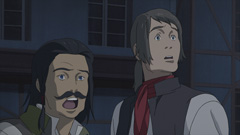Les 24 Chevaliers Part V: Yasuyuki Muto (Chief Writer) second half
This is the second part of our interview with Yasuyuki Muto, the chief writer for the series. Being responsible for 11 out of 24 episodes, his wide perspective of the entire series enabled him to insert various narrative tricks and give depth to not only the story, but also to the characters. Along with the director Kazuhiro Furuhashi and story supervisor Tow Ubukata, he is an indispensable part of the troika that supports the world of Le Chevalier D'Eon.
Part V (second half)
Yasuyuki Muto's In principio erat Verbum: "Kokubunji"!
 | Yasuyuki Muto Since his debut as a writer, he had tried to appeal to his most respected director, Kazuhiro Furuhashi, by, for instance, sending his original stories to him. And after the success he achieved in the TV series Basilisk, Muto eventually landed in Le Chevalier D'Eon team with Furuhashi's recommendation. He took up the task of imparting subtleties and human depth to each character who lived within the concept created by Tow Ubukata. He ended up contributing almost half of the episode scripts for the entire series. |
What is unique about writing scripts for Le Chevalier D'Eon?
Obviously, I pay close attention to the dialogue. Director Furuhashi as well as Ubukata-san, who is a novelist, both put a lot of weight on the dialogues, and we share similar feelings and views toward language and words. So I feel we had a basic coherent idea of what our intentions were quite early on in the process. I used symbolic renderings and also created scenes with only a description of the atmosphere; this included the theatrical scenes as well. In other words, I was able to omit excess renderings effectively and to a great degree. After everyone seriously worked at it for 24 episodes, I was able to see something simple and often forgotten, yet very important. This might sound overstated, but that was one of the crucial hints I gained as a creator.
This has been called a "substantially original" work. What is the difference from an "original work"?
The director is known to place a lot of weight on the script, so we decided on virtually every tiny detail of the scenes and the movements of the characters at the meetings. So I was able to designate these details in the scripts. Adding to this, because of the world in which the story takes place, I had to include an enormous amount of literary expressions in the lines as well as in the guidelines. That increased the size of the script: the first part amounted to eighty pages of 200-character writing paper, ninety pages for the middle part, and it peaked to more than one hundred pages for the final part. This would have been impossible if the production system limited the number of pages. Of course, rendering of each detail depends on the director and the anime supervisor who actually works with each storyboard. And also the airtime stays the same no matter how long the scripts are, so we have to keep in mind that we are working on a TV anime series, meaning that there will be certain budget restrictions (if we have more movements, then the number of drawings increases) and we also have to balance the amount of labor you put in.
You also attend the post recording sessions too.
Basically, I asked for permission to attend the sessions. Not to check whether they were following the script word for word, but among other reasons, I thought it would be easier for them to have a writer there to work out the problems that arise at the studio during the recording sessions. In regards to Le Chevalier D'Eon, "words" are one of the key issues and recordings are usually not changeable once they are done. I felt responsible in the first place, and I also wished to be there when the scenes that dwelled in my mind actually materialized. I wanted to witness that crucial moment.
Lastly, do you have a message for the audience?
I believe the chemistry between Ubukata-san and the animation staff made it possible to create a unique story of chivalry and the bond between people different from the stories told in novels and comics. The voice actors truly understood that and had put their heart into this work. Their effort crystallized into this Kokubunji-made (*) anime, Le Chevalier D'Eon. I hope you will enjoy it.
(end)
(*) Production I.G studios are located around the station of Kokubunji, in the outskirts of Tokyo.

![WORK LIST[DETAILS]](/contents/works/design/images/left_title.gif)



 terms of use
terms of use